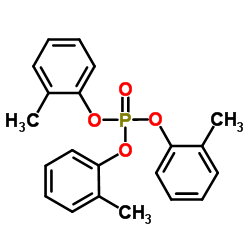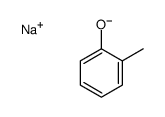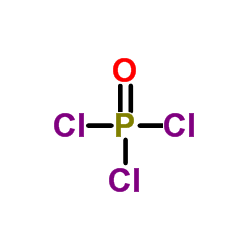78-30-8
| 中文名 | 磷酸三邻甲苯酯 |
|---|---|
| 英文名 | Tri-o-tolyl phosphate |
| 中文别名 |
磷酸三甲苯(酚)酯
邻磷酸三甲酚酯 磷酸三(2-甲苯)酯 磷酸邻三甲酚酯 |
| 英文别名 |
TOTP
Tris(o-tolyl) phosphate MFCD00041906 Tri-O-tolyl ester phosphoric acid tris(2-methylphenyl) phosphate Triorthocresyl phosphate TRICRESYL PHOSPHATE TRI-O-CRESYL PHOSPHATE Tri-o-tolyl phosphate Tritolyl phosphate EINECS 201-103-5 Phosphoric acid, tris(2-methylphenyl) ester |
| 密度 | 1.2±0.1 g/cm3 |
|---|---|
| 沸点 | 410.4±14.0 °C at 760 mmHg |
| 熔点 | -25 °C |
| 分子式 | C21H21O4P |
| 分子量 | 368.363 |
| 闪点 | 215.5±40.4 °C |
| 精确质量 | 368.117737 |
| PSA | 54.57000 |
| LogP | 5.48 |
| 外观性状 | 无色粘性液体 |
| 蒸汽压 | 0.0±0.9 mmHg at 25°C |
| 折射率 | 1.581 |
| 储存条件 | 本品密封阴凉避光保存。在储运中防止碰撞,小心轻放,切勿倒置。按有毒危险品规定储运。 |
| 水溶解性 | 水溶性:不溶;可溶于:乙醚,醇 |
| 分子结构 | 1、 摩尔折射率:102.14 2、 摩尔体积(m3/mol):306.6 3、 等张比容(90.2K):793.2 4、 表面张力(dyne/cm):44.7 5、 极化率(10 -24cm 3):40.49 |
| 计算化学 | 1.疏水参数计算参考值(XlogP):6.1 2.氢键供体数量:0 3.氢键受体数量:4 4.可旋转化学键数量:6 5.互变异构体数量:无 6.拓扑分子极性表面积44.8 7.重原子数量:26 8.表面电荷:0 9.复杂度:416 10.同位素原子数量:0 11.确定原子立构中心数量:0 12.不确定原子立构中心数量:0 13.确定化学键立构中心数量:0 14.不确定化学键立构中心数量:0 15.共价键单元数量:1 |
| 更多 | 1. 性状:无色或淡黄色透明油状液体 2. 密度(g/mL,25/4℃):1.183 3. 相对蒸汽密度(g/mL,空气=1):不确定 4. 熔点(ºC):不确定 5. 沸点(ºC,常压):410℃ 6. 沸点(ºC,5.2kPa):不确定 7. 折射率:不确定 8. 闪点(ºC):不确定 9. 比旋光度(º):不确定 10. 自燃点或引燃温度(ºC):不确定 11. 蒸气压(kPa,25ºC):不确定 12. 饱和蒸气压(kPa,60ºC):不确定 13. 燃烧热(KJ/mol):不确定 14. 临界温度(ºC):不确定 15. 临界压力(KPa):不确定 16. 油水(辛醇/水)分配系数的对数值:不确定 17. 爆炸上限(%,V/V):不确定 18. 爆炸下限(%,V/V):不确定 19. 溶解性:易溶于醇、醚和苯,几乎不溶于水。 |
|
磷酸三邻甲苯酯
修改号码:5
模块1. 化学品 产品名称: Tri-o-cresyl Phosphate 修改号码: 5 模块2. 危险性概述 GHS分类 物理性危害未分类
健康危害 特异性靶器官毒性神经系统 - 单一接触 [第1级] 特异性靶器官毒性神经系统 - 单一接触 [第1级] 环境危害 急性水生毒性 第2级 慢性水生毒性 第2级 GHS标签元素 图标或危害标志 信号词危险 危险描述 对器官引起损害: 神经系统 可能因延长或接触对器官产生损害: 神经系统 对水生生物有毒性 长期影响对水生生物有毒性 防范说明 [预防]切勿吸入。 避免释放到环境中。 使用本产品时切勿吃东西,喝水或吸烟。 处理后要彻底清洗双手。 [急救措施] 如接触到:呼叫解毒中心/医生。 收集溢出物。 [储存]存放处须加锁。 [废弃处置] 根据当地政府规定把物品/容器交与工业废弃处理机构。 磷酸三邻甲苯酯 修改号码:5 模块3. 成分/组成信息 单一物质/混和物单一物质 化学名(中文名):磷酸三邻甲苯酯 百分比: >96.0%(GC) CAS编码: 78-30-8 俗名: Phosphoric Acid Tri-o-tolyl Ester , Phosphoric Acid Tri-o-cresyl Ester , Tri-o-tolyl Phosphate 分子式: C21H21O4P 模块4. 急救措施 吸入: 将受害者移到新鲜空气处,保持呼吸通畅,休息。立即呼叫解毒中心/医生。 皮肤接触: 立即去除/脱掉所有被污染的衣物。用大量肥皂和水轻轻洗。 呼叫解毒中心/医生。 眼睛接触:用水小心清洗几分钟。如果方便,易操作,摘除隐形眼镜。 立即呼叫解毒中心/医生。 食入: 呼叫解毒中心/医生。漱口。 危害迹象: 头痛, 恶心, 呕吐, 虚弱, 腹痛 紧急救助者的防护:救援者需要穿戴个人防护用品,比如橡胶手套和气密性护目镜。 医生注意事项:根据接触程度,建议定期体检。 建议医学观察。 模块5. 消防措施 合适的灭火剂:干粉,泡沫,雾状水,二氧化碳 不适用的灭火剂:棒状水 特殊危险性:小心,燃烧或高温下可能分解产生毒烟。 特定方法:从上风处灭火,根据周围环境选择合适的灭火方法。 非相关人员应该撤离至安全地方。 周围一旦着火:如果安全,移去可移动容器。 消防员的特殊防护用具:灭火时,一定要穿戴个人防护用品。 模块6. 泄漏应急处理 个人防护措施,防护用具, 使用特殊的个人防护用品(自携式呼吸器)。远离溢出物/泄露处并处在上风处。确保 紧急措施:足够通风。 泄露区应该用安全带等圈起来,控制非相关人员进入。 环保措施:小心,切勿排入河流等。因为考虑对环境有负面影响。 控制和清洗的方法和材料:用合适的吸收剂(如:旧布,干砂,土,锯屑)吸收泄漏物。一旦大量泄漏,筑堤控 制。附着物或收集物应该立即根据合适的法律法规废弃处置。 模块7. 操作处置与储存 处理 技术措施:在通风良好处进行处理。穿戴合适的防护用具。防止烟雾产生。处理后彻底清洗双手 和脸。 注意事项:如果可能,使用封闭系统。如果蒸气或浮质产生,使用通风、局部排气。 操作处置注意事项:避免接触皮肤、眼睛和衣物。 贮存 储存条件:保持容器密闭。存放于凉爽、阴暗处。 存放处须加锁。 远离不相容的材料比如氧化剂存放。 包装材料:依据法律。 磷酸三邻甲苯酯 修改号码:5 模块8. 接触控制和个体防护 工程控制:尽可能安装封闭体系或局部排风系统。同时安装淋浴器和洗眼器。 接触极限: ACGIH TLV(TWA): 0.1 mg/m3 (skin) OSHA PEL(TWA): 0.1 mg/m3 个人防护用品 呼吸系统防护: 半面罩或全面罩呼吸器,自携式呼吸器(SCBA),供气呼吸器等。依据当地和政府法 规,使用通过政府标准的呼吸器。 手部防护:防渗手套。 眼睛防护:护目镜。如果情况需要,佩戴面具。 皮肤和身体防护:防渗防护服。如果情况需要,穿戴防护靴。 模块9. 理化特性 外形(20°C):液体 外观:透明 颜色: 微浅黄色-黄色 气味:无味 pH:无数据资料 熔点:无资料 沸点/沸程 410 °C 闪点: 225°C 爆炸特性 爆炸下限:无资料 爆炸上限:无资料 蒸气压: 0.2x10-2Pa/25°C 蒸气密度: 12.7 密度: 1.18 溶解度: [水]不溶于 [其他溶剂] 溶于: 醚, 酒精 log水分配系数 = 6.3 自燃温度: 385°C 模块10. 稳定性和反应性 化学稳定性:一般情况下稳定。 危险反应的可能性:未报道特殊反应性。 须避免接触的物质氧化剂 危险的分解产物: 一氧化碳, 二氧化碳, 磷氧化物 模块11. 毒理学信息 急性毒性: orl-mam LD50:400 mg/kg orl-mus LD50:900 mg/kg orl-rat LD50:1160 mg/kg skn-rbt LD50:>3700 mg/kg 对皮肤腐蚀或刺激:无资料 对眼睛严重损害或刺激:无资料 生殖细胞变异原性: dnd-rat-orl 500 mg/kg/10D-C 致癌性: IARC =无资料 NTP =无资料 磷酸三邻甲苯酯 修改号码:5 模块11. 毒理学信息 生殖毒性:无资料 RTECS 号码: TD0350000 模块12. 生态学信息 生态毒性: 鱼类:无资料 甲壳类:无资料 藻类:无资料 残留性 / 降解性: 65.7% (by BOD), 81.6% (by UV-VIS), 82.6% (by GC) 潜在生物累积 (BCF): 36000 土壤中移动性 log水分配系数: 6.3 土壤吸收系数 (Koc): 2.4 x 104 5.5 x 10-3 亨利定律 constant(PaM3/mol): 模块13. 废弃处置 如果可能,回收处理。请咨询当地管理部门。建议在装有后燃和洗涤装置的化学焚烧炉中焚烧。废弃处置时请遵守 国家、地区和当地的所有法规。 模块14. 运输信息 联合国分类: 第1项 毒害品。 UN编号: 2574 正式运输名称:三甲苯磷酸酯 包装等级: II 海洋污染物: Y 模块15. 法规信息 《危险化学品安全管理条例》(2002年1月26日国务院发布,2011年2月16日修订): 针对危险化学品的安全使用、 生产、储存、运输、装卸等方面均作了相应的规定。 模块16 - 其他信息 N/A |
|
毒理学数据: 可经皮肤或呼吸道吸入而引起中毒,发生多发性神经炎。严重中毒可造成胃肠障碍,食欲不振,并会引起腿、脚、臂及手的麻痹或肌肉萎缩等现象。空气中最高允许浓度为3mg/m3。 CHEMICAL IDENTIFICATION
HEALTH HAZARD DATAACUTE TOXICITY DATA
MUTATION DATA
|
| 符号 |



GHS07, GHS08, GHS09 |
|---|---|
| 信号词 | Danger |
| 危害声明 | H302-H370-H411 |
| 警示性声明 | P260-P273-P301 + P312 + P330-P308 + P311-P391-P501 |
| 危害码 (欧洲) | N-T,N,T |
| 风险声明 (欧洲) | R51/53 |
| 安全声明 (欧洲) | S61-S45-S28A-S20/21-S28 |
| 危险品运输编码 | 3082 |
| RTECS号 | TD0350000 |
| 包装等级 | II |
| 危险类别 | 6.1(a) |
|
~88% 
78-30-8 |
| 文献:Sagar; Shinde; Bandgar Organic Preparations and Procedures International, 2000 , vol. 32, # 3 p. 269 - 271 |
|
~88% 
78-30-8 |
| 文献:Sagar; Thorat; Salunkhe Synthetic Communications, 1994 , vol. 24, # 14 p. 2029 - 2033 |
|
~32% 
78-30-8 |
| 文献:Bull. Russ. Acad. Sci. Div. Chem. Sci. (Engl. Transl.), , vol. 41, # 9.1 p. 2039 - 2043,1585 - 1588 |
|
~% 
78-30-8 |
| 文献:European Journal of Inorganic Chemistry, , # 13 p. 2138 - 2147 |
|
~% 
78-30-8 |
| 文献:Journal of Organic Chemistry USSR (English Translation), , vol. 19, p. 789 - 790 Zhurnal Organicheskoi Khimii, , vol. 19, # 4 p. 892 |
|
~% 
78-30-8 |
| 文献:Justus Liebigs Annalen der Chemie, , vol. 224, p. 162 Chemische Berichte, , vol. 16, p. 1775 |






